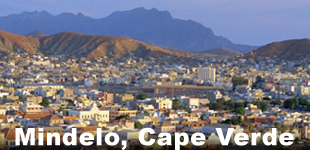This ALSO is Africa The Africa They Dont Show You On TV
Mindelo, Cape Verde
Cape Verde
 Portuguese (official), Crioulo (a blend of Portuguese and West African words)
Portuguese (official), Crioulo (a blend of Portuguese and West African words)
Creole (mulatto) 71%, African 28%, European 1%
Cape Verde has few natural resources, scant rainfall and limited supplies of fresh water.[citation needed] Only four of the ten main islands (Santiago, Santo Antão, Fogo, and Brava) normally support significant agricultural production,[30] and over 90% of all food consumed in Cape Verde is imported. Mineral resources include salt, pozzolana (a volcanic rock used in cement production), and limestone.[8] Its small number of wineries making Portuguese-style wines have traditionally focused on the domestic market, but have recently met with some international acclaim. A number of wine tours of Cape Verde’s various microclimates began to be offered in spring 2010 and can be arranged through the tourism office.[31]
The economy of Cape Verde is service-oriented, with commerce, transport, and public services accounting for more than 70% of GDP.[citation needed] Although nearly 38% of the population lives in rural areas, agriculture and fishing contribute only about 9% of GDP. Light manufacturing accounts for most of the remainder. Fish and shellfish are plentiful, and small quantities are exported. Cape Verde has cold storage and freezing facilities and fish processing plants in Mindelo, Praia, and on Sal. Expatriate Cape Verdeans contribute an amount estimated at about 20% of GDP to the domestic economy through remittances.[8]
Since 1991, the government has pursued market-oriented economic policies, including an open welcome to foreign investors and a far-reaching privatization programme. It established as top development priorities the promotion of a market economy and of the private sector; the development of tourism, light manufacturing industries, and fisheries; and the development of transport, communications, and energy facilities. From 1994 to 2000 about $407 million in foreign investments were made or planned, of which 58% were in tourism,[32] 17% in industry, 4% in infrastructure, and 21% in fisheries and services.[8]
In 2011, on 4 islands a windfarm was built, that in total supplies about 25% of the electricity of the country. With this amount it is one of the top countries for renewable energy.[33]
Between 2000 and 2009, real GDP increased on average by over 7 percent a year, well above the average for Sub-Saharan countries and faster than most small island economies in the region. Strong economic performance was bolstered by one of the fastest growing tourism industries in the world, as well as by substantial capital inflows that allowed Cape Verde to build up national currency reserves to the current 3.5 months of imports. Unemployment has been falling rapidly, and the country is on track to achieve most of the UN Millenium Development Goals – including halving its 1990 poverty level.
In 2007, Cape Verde joined the World Trade Organization (WTO) and in 2008 the country graduated from Least Developed Country (LDC) to Middle Income Country (MIC) status.[34][35]
Cape Verde has significant cooperation with Portugal at every level of the economy, which has led it to link its currency first to the Portuguese escudo and, in 1999, to the euro. On June 23, 2008 Cape Verde became the 153rd member of the WTO.[36]
[edit]